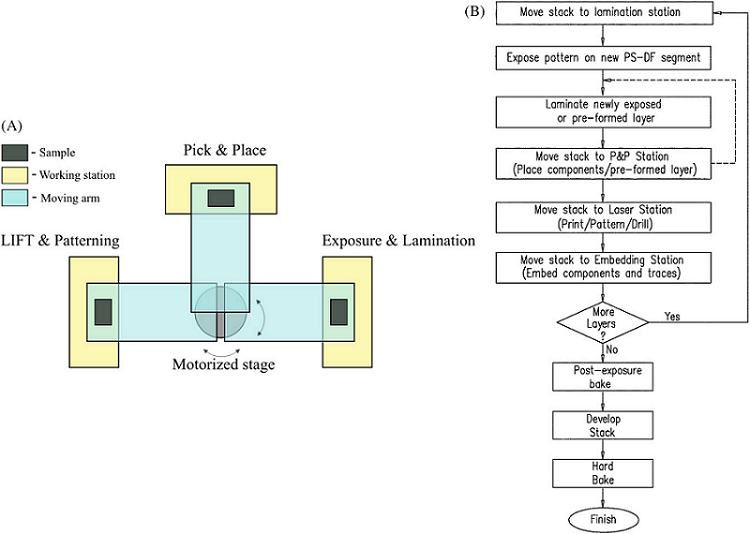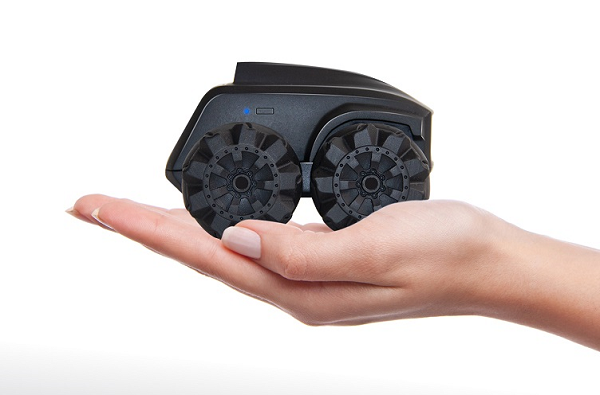In today’s 3D Printing News Briefs, we’ve got a couple of interesting research papers to tell you about, followed by a software release, a tiny autonomous robot, and how 3D printing and scanning can be used to help Olympic athletes stay at the top of the pack.
3D Printing Hybrid Structural Electronics

Schematic illustration of the hybrid printing concept (A) and detailed process flow (B). The system includes an exposure and lamination station, a component placement unit and a LIFT printing and patterning station all on the same tool. The sample is positioned on a moving arm that is situated on a motorized stage and may be moved between the different stations according to the building sequence. The structural material dry films are being printed within the exposure and lamination station which contains a patterning radiation source and a heating source for lamination. In the component placement unit, active and passive components are placed by an automated pick and place robot onto the built stack. Laser functions such as traces printing (LIFT), patterning and drilling (ablation) is done in the LIFT and patterning station.
A team of Israeli researchers from Ben‐Gurion University of the Negev (BGU) and Orbotech Ltd. published a paper about their work integrating three AM technologies—structural material printing with their novel Dry Film Stereolithography (DFS) method, printing electronics by laser induced forward transfer (LIFT), and component placement using a pick and place system (P&P)—in order to achieve high throughput printing of functional, electrically functional devices. The researchers say that applications for their unique hybrid method include smart packaging and the miniaturizing of devices.
The abstract states, “This article describes the combination of a novel, stereolithography (SLA) based method for structural material buildup with laser induced forward transfer (LIFT) printing of conductive and resistive elements and placement of commercial active and passive components for the additive manufacturing of 3D functional electronic devices. The structural material is composed of dry film photoresists that are exposed and laminated to form a stack which is later developed to remove unexposed area and reveal the desired free form shape. Interconnection using pillar penetration between the structural layers is described in detail. Several examples of functional objects (lamp, microphone) demonstrate the practicality of this novel, multi material printing method.”
You can read the full study here.
Digital Twins to Enhance Inkjet Printed Optics
In our second story on 3D printing research, a team from the Karlsruhe Institute of Technology (KIT) published a paper about developing a digital twin that helps adapt and enhance high-resolution inkjet 3D printing in order to make optical freeform surfaces with better shape fidelity. According to the paper, a digital twin is a “virtual equivalent of a real system” and is able to map, describe, and optimize physical objects based on a model. The researchers figured out how to adjust their 3D printing process to either increase or decrease material accumulation, or adjust curing strategies, to create better-performing optical components.
The abstract states, “3D-inkjet-printing is just beginning to take off in the optical field. Advantages of this technique include its fast and cost-efficient fabrication without tooling costs. However, there are still obstacles preventing 3D inkjet-printing from a broad usage in optics, e.g., insufficient form fidelity. In this article, we present the formulation of a digital twin by the enhancement of an optical model by integrating geometrical measurement data. This approach strengthens the high-precision 3D printing process to fulfil optical precision requirements. A process flow between the design of freeform components, fabrication by inkjet printing, the geometrical measurement of the fabricated optical surface, and the feedback of the measurement data into the simulation model was developed, and its interfaces were defined. The evaluation of the measurements allowed for the adaptation of the printing process to compensate for process errors and tolerances. Furthermore, the performance of the manufactured component was simulated and compared with the nominal performance, and the enhanced model could be used for sensitivity analysis. The method was applied to a highly complex helical surface that allowed for the adjustment of the optical power by rotation. We show that sensitivity analysis could be used to define acceptable tolerance budgets of the process.”
You can read the full study here.
Siemens Announces Latest Simcenter 3D Software Released

Evaluate sound performance with auralization: New in Simcenter 3D, pressure results as function of time (bottom right) can be played as an audio file.
Siemens Digital Industries Software recently announced that the latest release of its Simcenter 3D software, part of the company’s integrated Xcelerator portfolio, was available. The release features a new auralization post-processing tool so users can evaluate sound quality by listening to simulated pressure results, as shown above, in addition to full representative volume element (RVE) separation and 2D and 3D automatic insertion of cracks or cohesive zones in materials. Simcenter 3D 2021 has scaled the thermal analysis capabilities into a vertical solution for design engineers and mold designers, features new simulation types and enhanced AI-driven user experience, as well as a new NX Mold Cooling product. You can learn about the rest of Simcenter 3D enhancements and features here.
“Simcenter Multimech allows us to model microstructural cracks and determine how they would affect the overall part. Using this tool, we can actually see where a crack is developing, how the crack will change our material, and how it will affect the final microstructure of the material,” said Neraj Jain, group leader in simulation and engineering at the DLR Department of Ceramic Composites and Structures.
Tiny Robot with 3D Printed Extension Tools Can Monitor Home

The Scout robot can go into small spaces to clean or perform inspections in hard-to-reach locations.
Customer robots and robotic devices brand Moorebot, headquartered in California, recently launched its latest product, the tiny, autonomous Scout. The 2.8″ x 4″ x 4.3″ device offers smart home integration and audio/visual intelligence so it can recognize, follow, and interact with people and pets in the home, and uses a mobile camera to either monitor the home for security purposes or act as a children’s learning toy. Because of its small size, Scout can go where larger robotic devices can’t, such as under furniture…imagine you dropped your pen and it rolled under the couch, and instead of having to get down on the ground to retrieve it yourself, you could just send the robot!
With a modular design, the tiny Scout includes two-way audio, a 1080 p full high-definition camera and night vision, omni-directional wheels that automatically return it to the charging port, and it can also help teach kids STEM skills. If you want to upgrade Scout, the block-based visual programming language Scratch can be used to add features, and you can even design 3D printable extension tools so you can attach things like arms, a pet treat dispenser, a UV light germ-killing tool, and more. Moorebot anticipates that the Scout robot will be available for purchase sometime this spring.
USA Luge and Creaform Use 3D Printing and Scanning to Improve Sleds
The luge is one of the most extreme Olympic sports, with athletes flat on their back and careening down the icy track on a tiny sled, with no brakes, at speeds up to 90 mph in order to win the gold. Three former Olympians who now help run the show at USA Luge—Mark Grimmette, Gordy Sheer, and Jon Owen—know more than most that the kind of equipment you’re using can make or break a race, and wondered if they could use advanced technologies, like 3D printing, to make the sleds more comfortable, improve their aerodynamics, and quickly reproduce parts that have performed well in the past. A luge sled is tailored to an athlete’s body, and features two sharp steels that engage the ice, two bridges that support the pod, two runners with curved sections (horns) that help steer the sled, and the platform on which the slider lies, which his called the racing pod. USA Luge partnered with Creaform on several projects meant to help design and develop better luge sleds.
The blue laser HandySCAN 3D scanner captured the fine details of the set of steels U.S. athlete Summer Britcher used to win the World Cup in Germany so that the team could reproduce them, and also used Creaform’s handheld scanners to improve the aerodynamic shape of each racing pod: it’s designed by hand, then the model is scanned, and VXmodel scan-to-CAD post-processing software is used to make sure that all the surfaces are symmetrical and smooth. The technology also makes it easy to adjust the CAD model if improvements are needed. The HandySCAN 3D was used again to scan the complex, organic shapes of the luge horn, in order to ensure a perfect fit before it’s attached to the runner and wrapped in carbon fiber. Hopefully, these changes will help USA Luge take home the gold at the 2022 Winter Olympic Games in China.
Subscribe to Our Email Newsletter
Stay up-to-date on all the latest news from the 3D printing industry and receive information and offers from third party vendors.
You May Also Like
Gorilla Sports GE’s First 3D Printed Titanium Cast
How do you help a gorilla with a broken arm? Sounds like the start of a bad joke a zookeeper might tell, but it’s an actual dilemma recently faced by...
Nylon 3D Printed Parts Made More Functional with Coatings & Colors
Parts 3D printed from polyamide (PA, Nylon) 12 using powder bed fusion (PBF) are a mainstay in the additive manufacturing (AM) industry. While post-finishing processes have improved the porosity of...
$25M to Back Sintavia’s Largest Expansion of Metal 3D Printing Capacity Since 2019
Sintavia, the digital manufacturing company specializing in mission-critical parts for strategic sectors, announced a $25 million investment to increase its production capacity, the largest expansion to its operations since 2019....
Velo3D Initiates Public Offering in a Bid to Strengthen Financial Foundations and Drive Future Growth
Velo3D (NYSE: VLD) has been among a number of publicly traded 3D printing firms that have attempted to weather the current macroeconomic climate. After posting a challenging financial report for 2023,...

































